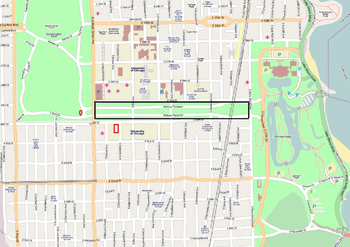Midway Plaisance facts for kids
Quick facts for kids |
|
|
Jackson Park Historic Landscape District and Midway Plaisance
|
|

View of Collegiate Gothic architecture of The University of Chicago, looking northwest from the grassy, tree-lined Midway.
|
|
| Location | Chicago, Illinois |
|---|---|
| Built | 1871 |
| Architect | Frederick Law Olmsted, Lorado Taft |
| NRHP reference No. | 72001565 |
| Added to NRHP | December 15, 1972 |
The Midway Plaisance, often called the Midway, is a famous public park in Chicago, Illinois. It's located on the city's South Side. This long, green space is about one mile long and 220 yards wide. It connects Washington Park on its west side and Jackson Park on its east side.
The Midway Plaisance separates the Hyde Park area from the Woodlawn area. It's about 6 miles (10 km) south of downtown Chicago, near Lake Michigan. Today, the Midway runs right through the southern part of the University of Chicago campus. Many university buildings are located along its edges.
The Midway became very well-known in 1893. It hosted the fun attractions at the World's Columbian Exposition, a huge world's fair. This is how the word "Midway" became popular for the amusement areas at fairs and carnivals.
The design of the Midway Plaisance was inspired by Frederick Law Olmsted. He was a famous landscape architect who also designed New York City's Central Park. Olmsted imagined a canal connecting the parks. Instead, the Midway has a dry ditch where the canal would have been. Later designers and artists also added their ideas to this green space.
Contents
What Does "Plaisance" Mean?

The word "plaisance" comes from the French word for "pleasance." It's an old word that means a "pleasure ground." Think of it as a beautiful park with shady paths, trees, and statues. It's a place designed for people to relax and enjoy themselves.
How the Midway Plaisance Began

The idea for the Midway Plaisance started in the 1850s. A land developer named Paul Cornell had a vision. He wanted to turn a swampy area south of Chicago into a beautiful park. This park would be a peaceful escape for city residents.
In 1869, Cornell and the South Park Commission began to make this dream a reality. They planned a large system of parks and boulevards. This system included Washington Park, Jackson Park, and the Midway Plaisance. The Midway was meant to connect the two larger parks with paths and waterways.
The famous firm of Olmsted, Vaux, and Co. was hired to design this urban oasis. Their plan included the Midway as a "magnificent chain of lakes." This would allow boats to travel from Washington Park to Jackson Park. From Jackson Park, boats could even reach Lake Michigan.
However, the detailed plans for the park were lost in the Great Chicago Fire of 1871. Rebuilding the city was very expensive. This meant there wasn't enough money to complete the grand park plans. So, the South Park area largely remained a natural swamp for a while.
The World's Columbian Exposition of 1893
The World's Columbian Exposition of 1893 was a huge event. It was held in the undeveloped parts of the South Park area. This world's fair celebrated Columbus's journey to the New World in 1492. It was one of the most successful and important world's fairs ever.
The fair covered over 600 acres (2.4 km²). It attracted visitors and exhibitors from all over the world. The mile-long Midway Plaisance became the fair's entertainment zone. It ran from Washington Park to Jackson Park.
A showman named Sol Bloom managed the Midway's attractions. It featured a mix of fun shows, educational exhibits, and exciting rides. One popular attraction was the "Street in Cairo," which introduced the "hootchy-cootchy" dance. It had 2.25 million visitors!
George Washington Gale Ferris Jr.'s original Ferris Wheel was also a huge hit. Over 1.5 million people rode it. The Midway's attractions and sideshows made over $4 million in 1893. For many visitors, the Midway was the most memorable part of the Exposition.
The Midway also had more serious exhibits. These were overseen by experts from Harvard University and the Smithsonian Institution. After the fair, the word "midway" became common in the United States. It now refers to the amusement area at any fair, circus, or amusement park.
The University of Chicago's Green Space

After the World's Fair, the Midway Plaisance returned to being a park. Frederick Law Olmsted's plans were revisited. Over the years, the Midway slowly became part of the University of Chicago. The university expanded in 1926 to be on both sides of the park.
Today, the Midway sits between the main university campus to the north. To the south are the university's professional schools. These include the University of Chicago Law School and the Harris School of Public Policy.
Artists like Lorado Taft and Eero Saarinen also added their ideas to the Midway. You can find a statue of Carl Linnaeus, who created modern taxonomy. There's also an equestrian statue by Albin Polasek of the Knight of Blanik. This legendary Czech hero is said to appear when his nation needs him most.
The Midway remains a mostly green area. It's a public space that has seen many ideas for its future. The sunken areas are now used for soccer games. There's also a new ice skating and sports facility. The tree-lined paths still honor Olmsted's original vision.
In 1999, a new plan for the Midway Plaisance was created. This plan was developed by the University of Chicago and the Chicago Park District.
The Midway's closeness to the university gave its early football teams a nickname. The University of Chicago Maroons were called the "Monsters of the Midway." This name was later used for the Chicago Bears football team. The university's football program was stopped for a while but has since been restarted. The Maroons now play at Stagg Field, north of the Midway.
Images for kids







